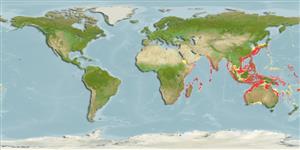Environment: milieu / climate zone / depth range / distribution range
Ecology
Marine; brackish; reef-associated; depth range 45 - 375 m (Ref. 33390). Tropical; 39°N - 35°S, 23°E - 179°W (Ref. 5222)
Indo-West Pacific: east coast of Africa to Japan, Korea, South China Sea, Viet Nam, and Fiji. Unknown from the Red Sea and Persian Gulf.
Length at first maturity / Size / Weight / Age
Maturity: Lm ?, range 41 - ? cm
Max length : 65.0 cm TL male/unsexed; (Ref. 4319); max. published weight: 4.0 kg (Ref. 5222)
Dorsal spines (total): 11; Dorsal soft rays (total): 14 - 15; Anal spines: 3; Anal soft rays: 8. Distinguished by the following characteristics: juveniles are pale yellowish grey in color, with oval black blotch on body between bases of the 3rd to 9th dorsal fin spines and extending to the edge of the fin between 1st and 7th spines; semicircular pale band passes ventrally around the oval black blotch and isolates it from the dark brown band that begins broadly on nape and bifurcates just behind operculum, upper branch curving dorsally and expanding broadly over the basal half of the dorsal fin between 9th spine and 4th soft ray, lower branch also curving dorsally and expanding at the base of the last 4 dorsal-fin rays; presence of 2nd curved band, parallel to the one above, runs from interorbital area and rear edge of the eye to a black saddle spot on caudal peduncle; 3rd narrow dark brown band, from lower edge of eye to the subopercle and continues as a series of dark dots along ventral part of the body to the base of caudal fin; pale yellow fins, except where dark markings occur on dorsal fin; adults with faint or absent dark spots on body; fins are yellowish brown, triangular interspinous dorsal fin margins abruptly orange-yellow or brownish yellow; soft dorsal, anal and caudal fins shading to blackish distally with bluish white edge; body depth contained 2.6-3.1 times in SL; head length 2.3-2.5 times in SL; interorbital area slightly convex; 2-5 enlarged serrae at preopercle angle; slightly convex upper edge of operculum; maxilla reaches about to vertical at rear edge of eye; maxilla in adults with step on edge; posterior nostrils of adults larger than anterior ones; 2 rows of teeth on midlateral part of lower jaw; pyloric caeca 8-9 (Ref. 89707).
Reef-associated (Ref. 89707). Inhabits relatively deep water (Ref. 5222). Feeds on fishes and crustaceans (Ref. 89707).
Life cycle and mating behavior
Maturity | Reproduction | Spawning | Eggs | Fecundity | Larvae
Heemstra, P.C. and J.E. Randall, 1993. FAO Species Catalogue. Vol. 16. Groupers of the world (family Serranidae, subfamily Epinephelinae). An annotated and illustrated catalogue of the grouper, rockcod, hind, coral grouper and lyretail species known to date. Rome: FAO. FAO Fish. Synop. 125(16):382 p. (Ref. 5222)
IUCN Red List Status (Ref. 130435: Version 2024-1)
Threat to humans
Harmless
Human uses
Fisheries: subsistence fisheries
Tools
Special reports
Download XML
Internet sources
Estimates based on models
Preferred temperature (Ref.
123201): 15.1 - 26.6, mean 20.7 °C (based on 556 cells).
Phylogenetic diversity index (Ref.
82804): PD
50 = 0.5000 [Uniqueness, from 0.5 = low to 2.0 = high].
Bayesian length-weight: a=0.01175 (0.00568 - 0.02430), b=3.04 (2.88 - 3.20), in cm total length, based on LWR estimates for this Genus-body shape (Ref.
93245).
Trophic level (Ref.
69278): 4.0 ±0.66 se; based on food items.
Resilience (Ref.
120179): Low, minimum population doubling time 4.5 - 14 years (Preliminary K or Fecundity.).
Fishing Vulnerability (Ref.
59153): Moderate to high vulnerability (46 of 100).
